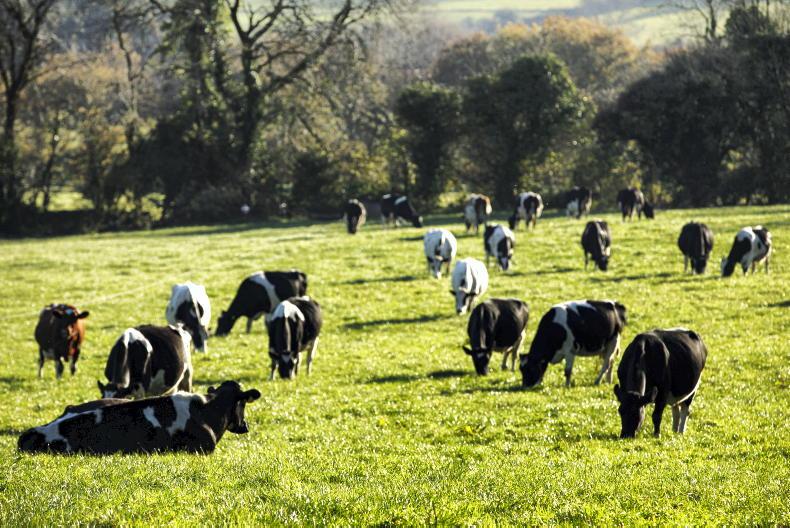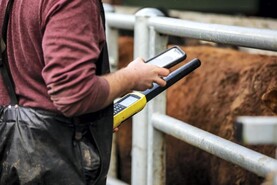Crude protein: At the online Teagasc dairy conference on Tuesday the importance of reducing the crude protein content in dairy rations was highlighted by Laurence Shalloo. He said the recent change in the organic nitrogen per cow figure from 85kg to 89kg was linked to milk production and the amount of protein the cow is consuming. A 1% reduction in crude protein of dairy concentrates reduces nitrogen excretion by 1.6kg, according to Shalloo. The Teagasc advice is to feed concentrates with a crude protein content of 12% to 14% when cows are at grass.
At this time of year, and with cows housed, the crude protein content of the rations will have to be higher. It won’t make much difference to cows that are in late lactation as their milk yield is low anyway. It is more important for freshly calved cows or cows at peak production in winter and liquid milk herds. How much protein is required in the ration is dependent on how much protein is in the forage and you need a forage analysis to tell you this. The overall level of protein in the diet should be around 15% to 17%. Typical crude protein level in silage is between 13% and 17%.
Dosing: Housed youngstock will need to be monitored for parasites and dosed if necessary. The main internal parasites to be concerned about are lungworms, stomach worms and fluke. One, some or all of these parasites will seriously affect thrive over the winter. At the same time you don’t want to dose these animals if they don’t have issues, as this could pose problems when they are adult animals and prevent them from developing immunity to stomach worms.
If animals look healthy and have no obvious symptoms of parasites such as coughing, loose dung or lack of thrive then they may not need to be dosed. To be sure, faecal egg counts should be taken. Ten or 12 dung samples can be pooled and sent away for analysis. It’s important to state that a negative result for lungworm in a dung sample doesn’t necessarily mean the animals don’t have lungworm. Dung sample results are effective for stomach worms and fluke. Choose doses carefully. If only treating adult parasites, the animals will need to be dosed twice, four to six weeks later.
For dairy cows, bulk milk sample results will tell you exposure to parasites such as stomach worms and fluke. According to the Glanbia herd screening results, 70% of the herds that participate don’t have exposure to fluke so don’t need to be dosed. Even where the bulk milk results are showing positive for stomach worms, I would still be inclined to get dung samples taken from cows just to be sure.
Choose products for dairy cows carefully as milk withdrawal dates can be very long on certain products. Recently dried off cows may need to be dosed before the rest of the herd is dry. It’s a bigger challenge for herds that milk the whole way through the winter. Good records are essential.
Dairy Day: All of the shows from our virtual Dairy Day are available to watch back for free and at any time on www.ifj.ie/dairyday.
Crude protein: At the online Teagasc dairy conference on Tuesday the importance of reducing the crude protein content in dairy rations was highlighted by Laurence Shalloo. He said the recent change in the organic nitrogen per cow figure from 85kg to 89kg was linked to milk production and the amount of protein the cow is consuming. A 1% reduction in crude protein of dairy concentrates reduces nitrogen excretion by 1.6kg, according to Shalloo. The Teagasc advice is to feed concentrates with a crude protein content of 12% to 14% when cows are at grass.
At this time of year, and with cows housed, the crude protein content of the rations will have to be higher. It won’t make much difference to cows that are in late lactation as their milk yield is low anyway. It is more important for freshly calved cows or cows at peak production in winter and liquid milk herds. How much protein is required in the ration is dependent on how much protein is in the forage and you need a forage analysis to tell you this. The overall level of protein in the diet should be around 15% to 17%. Typical crude protein level in silage is between 13% and 17%.
Dosing: Housed youngstock will need to be monitored for parasites and dosed if necessary. The main internal parasites to be concerned about are lungworms, stomach worms and fluke. One, some or all of these parasites will seriously affect thrive over the winter. At the same time you don’t want to dose these animals if they don’t have issues, as this could pose problems when they are adult animals and prevent them from developing immunity to stomach worms.
If animals look healthy and have no obvious symptoms of parasites such as coughing, loose dung or lack of thrive then they may not need to be dosed. To be sure, faecal egg counts should be taken. Ten or 12 dung samples can be pooled and sent away for analysis. It’s important to state that a negative result for lungworm in a dung sample doesn’t necessarily mean the animals don’t have lungworm. Dung sample results are effective for stomach worms and fluke. Choose doses carefully. If only treating adult parasites, the animals will need to be dosed twice, four to six weeks later.
For dairy cows, bulk milk sample results will tell you exposure to parasites such as stomach worms and fluke. According to the Glanbia herd screening results, 70% of the herds that participate don’t have exposure to fluke so don’t need to be dosed. Even where the bulk milk results are showing positive for stomach worms, I would still be inclined to get dung samples taken from cows just to be sure.
Choose products for dairy cows carefully as milk withdrawal dates can be very long on certain products. Recently dried off cows may need to be dosed before the rest of the herd is dry. It’s a bigger challenge for herds that milk the whole way through the winter. Good records are essential.
Dairy Day: All of the shows from our virtual Dairy Day are available to watch back for free and at any time on www.ifj.ie/dairyday.






 This is a subscriber-only article
This is a subscriber-only article










SHARING OPTIONS: